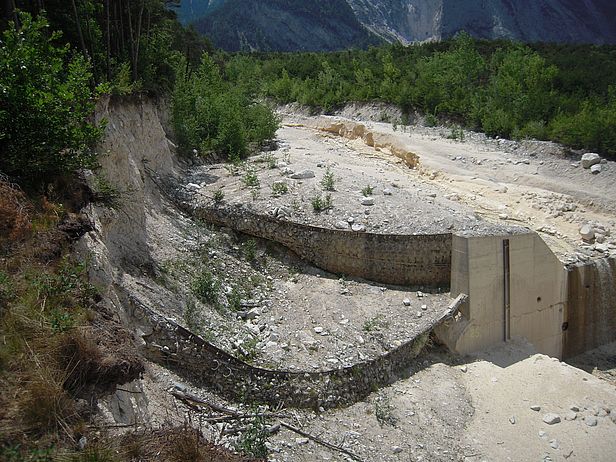21.12.2020 | Rahel Künzler | News WSL
Light, flexible and highly resilient net barriers against debris flows and hillslope debris flows have only been around for a few years. Where could they be deployed and how should they be designed and dimensioned? A new WSL report, funded by the Swiss Federal Office for the Environment (FOEN) and Federal Roads Office (FEDRO), discusses experiences with the new safety nets and is intended as a decision-making aid for authorities, project managers and engineers.
After heavy rain, debris flows comprising masses of mud and rocks can suddenly plunge down a slope, following the course of mountain streams. On steep terrain, entire slopes can liquefy and start to move, in a phenomenon known as hillslope debris flows. Both types of flow can reach speeds of over 50 kilometres per hour and bury buildings, roads and railway lines. In many parts of the Swiss Alps, protective structures (among other measures) reduce the risk of damage from these sudden and highly destructive natural events. Such structures usually take the form of massive walls or embankments made from reinforced concrete or earth.
Protective nets: a versatile option
However, for the past decade or so, there has been an alternative on the market in the form of flexible safety nets made of steel cables or high-tensile steel wire. These are cheaper to install, take up less space, blend in better with the landscape and could replace or supplement some rigid concrete barriers. A team of authors from the Swiss Federal Institute for Forest, Snow and Landscape Research (WSL), the Canton of Appenzell Ausserrhoden and a number of engineering firms has now compiled a practical guide providing an overview and recommendations for their use and maintenance.
Flexible safety nets have been used as rockfall barriers or snow nets for decades all over the world. The performance of these systems has improved greatly during that time, meaning that they are now able to withstand the enormous forces of debris flows and hillslope debris flows. Indeed, their flexibility and meshed structure make them an ideal means of curbing these natural hazards. The deformation of the net and its built-in braking elements absorb the initial force of the debris, after which the water can flow through the mesh, thus compacting the retained material. Together, these factors enhance both braking and retention effectiveness.
In a project carried out between 2005 and 2011 and co-financed by Switzerland's federal government, a development team from Geobrugg AG (based in Romanshorn, canton of Thurgau) joined forces with WSL to optimise existing rockfall protection systems in order to cope with the unique loads associated with debris flows and hillslope debris flows. They tested the newly developed nets in a large-scale trial in the Illgraben gully near Leuk in the canton of Valais, where debris flows are particularly common. This was followed by other projects involving artificially triggered hillslope debris flows. Other manufacturers developed similar products over the same period, sometimes also in collaboration with universities or research institutes.

Around 80 debris flow and 30 hillslope debris flow nets have been installed in Switzerland since 2007. The fact that they are relatively quick and easy to install has proved to be one of their greatest practical advantages over rigid concrete structures. Components and equipment can be transported by helicopter, even in hard-to-access areas, and construction usually takes no more than a few weeks, which also makes the nets attractive as an immediate or emergency measure. Moreover, multiple net barriers can be set up one behind the other to increase the retention volume.
The installations undertaken to date have yielded valuable insights into the operation and maintenance of these structures. Occasional instances of damage to the barriers help experts understand what steps can be taken to prevent this and how the structures could be optimised in the future.
Heavy rain becoming more frequent
If global warming results in an increase in permafrost thawing and heavy precipitation events, debris flows and hillslope debris flows are likely to become more frequent and intense, meaning that the use of protective nets could make more and more sense. «As an emergency measure or as protection for a single road or building, safety nets can be installed quickly,» says Christoph Graf, a geomorphologist at WSL and co-author of the guide. They could also supplement existing protective structures or be used as customised structures for retaining driftwood. «Their wide range of possible applications mean that protective nets are often an attractive alternative to rigid concrete structures. This technology should therefore definitely be included in the evaluation and planning of local measures in at-risk areas.»
The Swiss Federal Institute for Forest, Snow and Landscape Research (WSL) was involved in the project, commissioned by the Federal Office for the Environment (FOEN) and the Federal Roads Office (FEDRO), to assess the potential of the new protective nets from a technical, economic and environmental perspective. The main focus was on practical application and design, as well as the opportunities and limitations of net barriers. The results are published in the new WSL report «Praxishilfe Murgang- und Hangmurenschutznetze»(Practical guide to debris flow and hillslope debris flow safety nets).
Contact
Publications
Links
Copyright
WSL and SLF provide the artwork for imaging of press articles relating to this media release for free. Transferring and saving the images in image databases and saving of images by third parties is not allowed.
